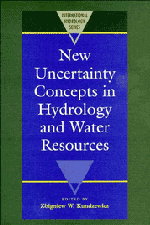Book contents
- Frontmatter
- Contents
- List of Authors
- Preface
- I INTRODUCTION
- II FACETS OF UNCERTAINTY
- III NOVEL APPROACHES TO UNCERTAINTY: FRACTALS, FUZZY SETS AND PATTERN RECOGNITION, NON-PARAMETRIC METHODS
- IV RANDOM FIELDS
- 1 Analysis of regional drought characteristics with empirical orthogonal functions
- 2 Worth of radar data in real-time prediction of mean areal rainfall by nonadvective physically-based models
- 3 Uncertainty analysis in radar-rainfall estimation
- 4 Design of groundwater monitoring networks for landfills
- 5 Spatial variability of evaporation from the land surface – random initial conditions
- 6 Detecting outliers in flood data with geostatistical methods
- V TIME SERIES AND STOCHASTIC PROCESSES
- VI RISK, RELIABILITY AND RELATED CRITERIA
4 - Design of groundwater monitoring networks for landfills
Published online by Cambridge University Press: 07 May 2010
- Frontmatter
- Contents
- List of Authors
- Preface
- I INTRODUCTION
- II FACETS OF UNCERTAINTY
- III NOVEL APPROACHES TO UNCERTAINTY: FRACTALS, FUZZY SETS AND PATTERN RECOGNITION, NON-PARAMETRIC METHODS
- IV RANDOM FIELDS
- 1 Analysis of regional drought characteristics with empirical orthogonal functions
- 2 Worth of radar data in real-time prediction of mean areal rainfall by nonadvective physically-based models
- 3 Uncertainty analysis in radar-rainfall estimation
- 4 Design of groundwater monitoring networks for landfills
- 5 Spatial variability of evaporation from the land surface – random initial conditions
- 6 Detecting outliers in flood data with geostatistical methods
- V TIME SERIES AND STOCHASTIC PROCESSES
- VI RISK, RELIABILITY AND RELATED CRITERIA
Summary
ABSTRACT Designing a system to monitor groundwater for contamination from landfills involves a tradeoff between cost, time of detection, and probability of detection. As monitoring wells are spaced more closely together, the probability of detecting a leak improves. Locating monitoring wells further downgradient of the landfill also improves detection probability because the plume disperses more and is less likely to move undetected between two monitoring wells. However, closer spacing costs more, and location further away from the source implies a greater time of detection and a greater probability that a water supply well will become contaminated.
An important problem in designing a monitoring system is that the hydraulic conductivity properties of the aquifer around and under the landfill are often poorly understood. It is possible to test for these properties only at points and interpolation between them may be done only with some uncertainty.
A method is discussed for designing a monitoring system under parameter uncertainty. This method places a given number of wells (the number selected by the analyst or user) in locations that maximize the probability of detection of a plume. The method requires some prior knowledge of the statistical properties of the conductivity parameters of the aquifer and some knowledge of the probability of a leak occurring at any given point in the landfill. The method is microcomputer based and currently runs on an advanced microcomputer workstation. The possibility for its adaptation to a more readily available microcomputer is discussed.
Information
- Type
- Chapter
- Information
- New Uncertainty Concepts in Hydrology and Water Resources , pp. 190 - 196Publisher: Cambridge University PressPrint publication year: 1995
Accessibility standard: Unknown
- 1
- Cited by
